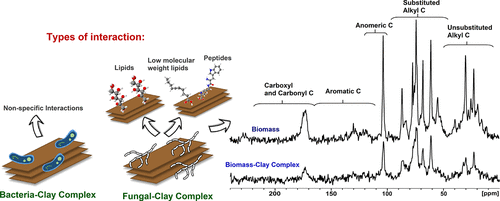当前位置:
X-MOL 学术
›
ACS Earth Space Chem.
›
论文详情
Our official English website, www.x-mol.net, welcomes your feedback! (Note: you will need to create a separate account there.)
Unraveling Mechanisms behind Biomass–Clay Interactions Using Comprehensive Multiphase Nuclear Magnetic Resonance (NMR) Spectroscopy
ACS Earth and Space Chemistry ( IF 3.4 ) Pub Date : 2020-11-02 , DOI: 10.1021/acsearthspacechem.0c00215 Melisa S. Olivelli 1, 2 , Ioana Fugariu 3 , Rosa M. Torres Sánchez 2, 4 , Gustavo Curutchet 1, 2 , André J. Simpson 3 , Myrna J. Simpson 3
ACS Earth and Space Chemistry ( IF 3.4 ) Pub Date : 2020-11-02 , DOI: 10.1021/acsearthspacechem.0c00215 Melisa S. Olivelli 1, 2 , Ioana Fugariu 3 , Rosa M. Torres Sánchez 2, 4 , Gustavo Curutchet 1, 2 , André J. Simpson 3 , Myrna J. Simpson 3
Affiliation

|
The interactions of the different components of soils, such as living biomass and organic matter, with mineral surfaces are of considerable interest due to their environmental reactivity and potential for improving carbon storage in the long-term. Also, microbial species are known to participate in key soil processes, and it has been hypothesized that microbes do not just sorb to minerals but also actively bind to minerals and may even play an important role in mineral formation. Nuclear magnetic resonance (NMR) spectroscopy is one of the most powerful tools to study the structure and association in complex samples. A new NMR technique, referred to as comprehensive multiphase (CMP) NMR spectroscopy, has been applied to analyze unaltered samples in novel NMR experiments to study structures and interactions in situ. In this research, we use CMP-NMR to study biomass–clay interactions in laboratory-generated biomass–clay complexes. CMP-NMR analyses showed that fungal biomass associates with clay mainly via aliphatic functional groups, while carbohydrates dominate at the clay–water interface. The results for bacterial cells suggest the formation of a biofilm that attached non-specifically to clay surfaces. This is the first time that a molecular approach of whole-cell attachment to clay in biomass–clay complexes is obtained with this technique. This in-depth molecular information provides a unique insight into the binding mechanisms between biomass and clay minerals. This novel information can improve the fundamental understanding of soil organic matter formation and stabilization processes involved in soil formation, as well as the role of the mineral fraction of whole soils in biomass/organic matter protection or the preferential binding of pollutants.
中文翻译:

使用全面的多相核磁共振(NMR)光谱分析生物质-粘土相互作用背后的机理
土壤的不同组成部分(例如活的生物质和有机物)与矿物表面之间的相互作用备受关注,因为它们具有环境活性,并具有长期改善碳储存的潜力。而且,已知微生物物种参与关键的土壤过程,并且已经假设微生物不仅吸附到矿物质上,而且还主动地结合到矿物质上,甚至可能在矿物质形成中起重要作用。核磁共振波谱学是研究复杂样品中结构和缔合的最强大工具之一。一种新的NMR技术,称为综合多相(CMP)NMR光谱学,已被用于在新颖的NMR实验中分析未改变的样品,以就地研究结构和相互作用。在这项研究中,我们使用CMP-NMR研究实验室生成的生物质-粘土复合物中生物质-粘土的相互作用。CMP-NMR分析表明,真菌生物质主要通过脂肪族官能团与粘土缔合,而碳水化合物在粘土-水界面占主导地位。细菌细胞的结果表明形成了生物膜,该生物膜非特异性地附着在粘土表面上。这是首次通过这种技术获得了一种将生物质黏土复合物中黏附到整个细胞的分子方法。这种深入的分子信息提供了对生物质和粘土矿物之间结合机制的独特见解。这些新颖的信息可以增进对土壤有机物形成和土壤形成过程中稳定过程的基本了解,
更新日期:2020-11-19
中文翻译:

使用全面的多相核磁共振(NMR)光谱分析生物质-粘土相互作用背后的机理
土壤的不同组成部分(例如活的生物质和有机物)与矿物表面之间的相互作用备受关注,因为它们具有环境活性,并具有长期改善碳储存的潜力。而且,已知微生物物种参与关键的土壤过程,并且已经假设微生物不仅吸附到矿物质上,而且还主动地结合到矿物质上,甚至可能在矿物质形成中起重要作用。核磁共振波谱学是研究复杂样品中结构和缔合的最强大工具之一。一种新的NMR技术,称为综合多相(CMP)NMR光谱学,已被用于在新颖的NMR实验中分析未改变的样品,以就地研究结构和相互作用。在这项研究中,我们使用CMP-NMR研究实验室生成的生物质-粘土复合物中生物质-粘土的相互作用。CMP-NMR分析表明,真菌生物质主要通过脂肪族官能团与粘土缔合,而碳水化合物在粘土-水界面占主导地位。细菌细胞的结果表明形成了生物膜,该生物膜非特异性地附着在粘土表面上。这是首次通过这种技术获得了一种将生物质黏土复合物中黏附到整个细胞的分子方法。这种深入的分子信息提供了对生物质和粘土矿物之间结合机制的独特见解。这些新颖的信息可以增进对土壤有机物形成和土壤形成过程中稳定过程的基本了解,


























 京公网安备 11010802027423号
京公网安备 11010802027423号